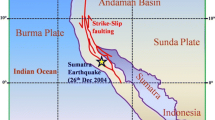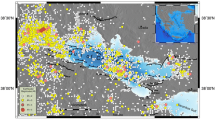Abstract
The Vrancea seismic region contains an isolated cluster of events beneath the Carpathian Arc Bend in Romania, dipping to about 200 km depth. Seismic activity mainly occurs at intermediate depths (h > 60 km). The main goal of the paper is to perform an in-depth, complex analysis of the occurrence times of these intermediate-depth events. We also try to show the versatility of the methods used to characterize different aspects of the seismicity evolution and to offer a user-friendly software toolbox to do most of the related computations. The earthquake catalog used in this study spans from 1974 to 2002 and includes only the intermediate-depth events. In the first part of the paper, we analyze the multifractal characteristics of the temporal distribution of earthquakes. The study reveals two distinct scaling regimes. At small scales we found a clear nonhomogeneous, multifractal pattern, while at large scales the temporal distribution of events shows a monofractal, and close to Poissonian (random), behavior. The multifractal behavior at small scales (minutes-hours) is shown to be clearly an effect of the “short” aftershock sequences that occurred after some major Vrancea earthquakes. In the second part of the paper we analyze whether our temporal series shows a persistent (or anti-persistent) long-term behavior, by using the Detrended Fluctuation Analysis (DFA) method. The results suggest that the analyzed temporal series of Vrancea earthquakes is a non-correlated process. In part three of the paper we seek to determine whether the dynamics of our earthquake system (described by the occurrence time of Vrancea earthquakes) is deterministically chaotic, deriving from a rather simple evolution law, or whether it is stochastic and is generated by a system that possesses many degrees of freedom. The results suggest that our signal is stochastic (probably does not possess an attractor). The limited time-span of the catalog and the analysis performed in this paper cannot rule out the emergence of an interesting, quasi-deterministic and low-dimensional structure in the case of major Vrancea earthquakes.
Similar content being viewed by others
Author information
Authors and Affiliations
Corresponding author
Additional information
Acknowledgement One of the authors (BE) is grateful to the Japanese Ministry of Education for providing him a Monbusho scholarship for studying in DPRI, Kyoto University. We thank Z.R. Struzik, M Holschneider, J. Mori and D. Kaplan for their useful comments, and acknowledge the support of the staff of DPRI, Kyoto University and the National Inst. for Earth Physics, Bucharest. We thank the two reviewers, M.B. Geilikman and M. Anghel, for their useful suggestions which improved the quality of this work.
Rights and permissions
About this article
Cite this article
Enescu, B., Ito, K., Radulian, M. et al. Multifractal and Chaotic Analysis of Vrancea (Romania) Intermediate-depth Earthquakes: Investigation of the Temporal Distribution of Events. Pure appl. geophys. 162, 249–271 (2005). https://doi.org/10.1007/s00024-004-2599-x
Received:
Accepted:
Issue Date:
DOI: https://doi.org/10.1007/s00024-004-2599-x




